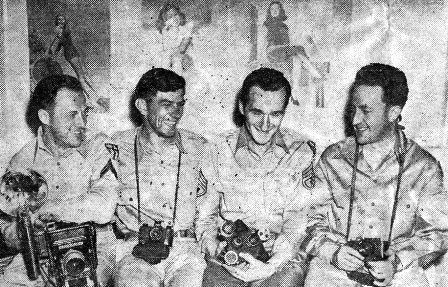

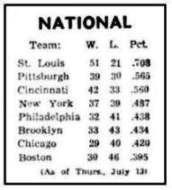
VOL. II NO. 43 REG NO. L5015 DELHI, THURSDAY JULY 6, 1944
NORTHERN BURMA - Chinese and Chindit forces this week chewed up the dwindling pocket of Jap resistance sandwiched between the captured Mogaung Valley towns of Kamaing and Mogaung; while, in besieged Myitkyina, The Chinese-American-Anglo units storming that stronghold brought closer to an end the suicidal efforts of the enemy to maintain their weakened grip. Death everywhere stalked the remnants of the 18th Jap Division and in Lt. Gen. Joseph W. Stilwell's Headquarters grim satisfaction was evidenced.
After last week's seizure of Mogaung, Stilwell's forces fanned out to the east and west along the tortuous Burma Railroad, which winds from Rangoon to Myitkyina. Westward, they drove beyond Loilaw in a series of aggressive attacks, during which they killed over 500 Japs and captured a large quantity of booty, including five light tanks, machines guns, mortars and small arms. Eastward, they pounced upon Namti, where 50 railway wagons were added to the Allied loot.
Coincidentally, an attack was launched upon Parentu along the motor road from Mogaung to Myitkyina. In the savage fighting that resulted, 110 Japs were killed.
Meanwhile, the dissolving Jap pocket of resistance below Seton along the Kamaing-Mogaung Road was given a severe mauling. Severe casualties were inflicted upon the enemy, while valuable captured material included five 150mm guns, two 70mm field guns, anti-tank weapons, machine guns and well over 100 trucks.
Below Mogaung, the Chindits engaged the Japs in a severe 90-minute battle, at the end of which the enemy decided it had enough and got the hell out of there in a big hurry.
From within the ruins of Myitkyina, the Jap still snarled defiance, but his numbers were whittled, his perimeter shrunk, his hope dissolving. The most important Allied gains were made in the southern section of Myitkyina, where, three days apart, Nip counter-attacks were repulsed.
One of the most unexplainable of the Jap actions of the week was a suicidal effort to penetrate into the main airport from the west of Myitkyina. Yank troops blunted this thrust, surrounded the force and completely wiped it out.
South of Myitkyina, strong positions were established by the Chinese north of the Waingmaw Ferry Road.
|
DECORATING LEDO ROAD
ALONG THE LEDO ROAD - What the Fifth Army in Italy has got on the Ledo Road Engineers (See May 25 Roundup) is nothin' when it comes to visual application of the feminine form divine. The lovelies on the G.I. signs in Italy were, we note, 99 percent nude. Well, let it be said that the nudes on the signs along the Ledo Road are 99.9 percent nude.
Here, at a snaky section of the road, is a life-sized figure of a particularly luscious redhead, appealing, arms out-stretched, "I want my soldier boy to come home, too. Watch those !?!? curves!"
There, along another stretch, stands a cut-out curvaceous blonde with this warning across her - er - ah - tummy, "Bad Curves. Be Cautious."
At still another spot reclines a dusky wench resembling a cross between Hazel Scott and Lena Horne, combining the better points of each. All she says (or needs to say) is "Be Careful."
It's hardly necessary to state that these works of art receive a lot of attention. In fact it is reliably reported that one dogface was paying so much attention that he ran himself into a small ditch.
Nor does the brass pass by the signs without arching an eyebrow. So far, however, there have been no complaints from any colonels or generals.
OVERSEAS SERVICE STRIPES
AUTHORIZED BY WAR DEPARTMENT
Shucks, fellers. The War Department has dreamed up some more stuff for us to lug around. But you probably won't mind it at all. Beginning right now, service stripes for overseas duty are authorized. Here's the deal:
For every six months spent overseas, you rate a gold service stripe. The overseas duty must have been put in any time between Pearl Harbor and six months after the termination of the war; you count your time from the day you left the States until the day you got back.
The stripe can be worn on the uniform coat, the shirt (or bush shirt), or the field jacket.
For the blouse, it will be gold lace or bullion, one and three-eighths inches long, and eighth of an inch wide, mounted on an O.D. border. For the others, same size, golden yellow cloth mounted on Khaki.
If you haven't any other hash marks, wear it centered on your left sleeve, four inches from the end. (Yeah the cuff end). If you already have stripes for three-year hitches, or has from the last war, wear the new ones above the top-most of the old ones.
The new stripes will be issued to G.I.'s, for sale to officers, and should be available in not more than two months.
|
BY SALWEEN CHINESE
SALWEEN - On the northern end of the Chinese Salween offensive, the troops of Marshal Wei Li Huang this week were attacking the outer defenses of Tengchung, chief communications and supply point in this sector.
To the south, Lungling was still a stubbornly contested area, with considerable casualties being suffered by both sides in hand-to-hand fighting.
The gap between the Chinese Expeditionary Force and Lt. Gen. Joseph W. Stilwell's forces around Myitkyina has been lessened during the week's fighting. Union of these forces is expected to break off the two-year-old Jap blockade of the old Burma Road and pinch off the enemy forces in Northern Burma and adjacent China.
Jap planes made their first appearance since the Chinese first surged across the Salween. A small quantity of supplies was air-dropped to the beleaguered enemy garrison at Sungshan.
Except for this instance, the 14th Air Force had complete control of the air. Improved flying weather gave the 14th B-25's visibility to blast Mangshih. The 14th also flew numerous sorties, keeping Jap transport on the Burma Road in constant chaos by strafing and bombing.
Strong Chinese combat patrols have also cut Jap traffic along the Road from Lungling to Mangshih. Heaviest casualties were suffered by both sides at Huangthapoa, six miles northwest of Lungling.
Minor action was reported from the northern Shweli River Valley area.
G.I.'S TAKE TO SHELTER BEFORE JAPS' AIR FORMATION
But Enemy Bombers Turn Out To Be Ducks
AN ADVANCED BASE SOMEWHERE IN CHINA - A two-ball alert was on at this China base. But nothing had happened, the danger seemed well past, and ground crews and officers were grouped around the alert shack, watching two of our fighters patrol below the overcast clouds.
Suddenly, an agonized yell tore the air, and a finger pointed out a formation in the familiar Japanese "V" coming in low. No one stood on the order of his going. Everybody hit for cover. Watery slit trenches were quickly populated with more than frogs.
Then cautious heads peeked out. On came the formation, its "V" unwavering. And no opposition was near, except our two fighters ahead of it, obviously unaware of the danger.
Still on it came, but as the flight passed over the field, it was strangely silent, and there was a flapping of wings.
And out of the trenches, muddy but unscarred, climbed the shamefaced victims of a daring raid carried out by fast-flying ducks!
|
200 Chinese Youths Learn Plane Making
SAN FRANCISCO - (UP) - The China Aircraft Corporation, only airplane manufacturing plant in the world owned and operated entirely by the Chinese, will be turning out parts of the B-26 within the next 30 days.
Dr. Hu Seng Chiu, 25-year-old graduate of M.I.T. and the company's founder and chief engineer, said that 200 young Chinese were learning the trade in the Santa Monica plant of the Douglas Aircraft Corporation.
He indicated that after the war, the entire plant might be moved to China, there to form the nucleus of a Chinese national air industry.
Dud Bomb Sinks Two Jap Ships
Boy, page Mr. Ripley! With an absolutely straight face, 14th Air Force Public Relations tells of the following remarkable feat by Lt. Col. Louis B. Hughes, Jr., of Kansas City, Mo.:
Hughes, commander of a P-40 detachment spotted two steel ships. One was about 100 feet long, the other 150 feet. With his fighter just above the surface of the water, he raced in to attack, released his bomb, and zoomed over the vessels at masthead height, escaping with only his tail section slightly nicked by machine gun fire (the airplane's that is).
Observing no explosion, he thought the attack a failure, until subsequent aerial reconnaissance showed both ships had settled to the bottom. The dud bomb, it seems, had sliced through the hulls of both like a hot knife through butter.
Hughes received the Air Medal for this job.
TWIN DRAGON SQUADRON PROVES SKY SCOURGE TO JAPAN
Roundup Staff Article from information supplied by Lt. John M. Morton, Jr.
ADVANCED EAST INDIA AIR BASE - You'll have to forgive the sage who first observed "Lightning doesn't strike twice in the same place." After all, he had no way of knowing that World War II would introduce the Lockheed P-38 Lightning and such squadrons as CBI-land's "Twin Dragon."
In less than 90 days, this Third Tactical Air Force, EAC outfit either scourged from the sky or destroyed on the ground 126 of their Jap adversaries. This was a spectacular average of better than four planes for each P-38 in the squadron. For each of the silver twin-finned sky terrors they lost, the "Dragons" claimed 12 Nips.
Quite a record, falling only a few planes short of the mark in all the Pacific Theaters for original pilot personnel of the squadron.
C.O. of the "Dragons" is chunky, mustached, picturesque Maj. Verl D. Luehring, who personally led most of the first fighter sweeps. many times, up to 30 enemy planes were on patrol over their bases waiting to pounce upon the Major and his marauders. Three short weeks after the squadron flew its first operational mission over Burma, Luehring was ordered to employ it as top cover for bombers wreaking havoc upon Rangoon, 1,200 round-trip miles.
The "Dragon" with the sharpest claws is missing in action - Capt. Walter F. Duke. Before he failed to return to base, 22-year-old Duke destroyed 10 Japs in the air and nine on the ground to become the India-Burma Theater's leading ace. Additionally, he probably destroyed and damaged nine other Nips.
Of the other "Dragon" aces, Maj. Maxwell H. Glenn's record of eight decisions in the air and 10 aground is the most spectacular, for he bagged five Jap aircraft on one mission. Capt. Hampton Boggs also has eight "kills" in the air, three in one mission, and four aground. Lt. Harry H. Sealy's total is 10 in the air and on the ground. Maj. Willard J. Webb joined the ace ranks with five Nips in combat and added three on the ground for good measure.
Writes Morton : -
"It would be difficult to select any one factor as being responsible for the "Twin Dragons" success. Good leadership, pilot superiority, teamwork, Jap psychology and eagerness of our pilots to strike a blow against the Japs - all enter into the picture.
"Certainly, the twin-engined P-38, with its 20mm cannon and four 50's, has played havoc among Jap planes and airfields. Its ruggedness and durability have brought back 14 pilots on one engine.
"The qualities have inspired in the pilots a confidence that has allowed them to utilize its qualities to the best advantage. This, combined with superior marksmanship, has given them the edge."
14TH A.F. STRAFES JAPS ON HANKOW-CANTON R.R.
14TH AIR FORCE, CHINA - Fighters and bombers of the 14th Air Force celebrated their second anniversary this week by stepping up the tempo of attacks on the Japanese powerhouse of five divisions pounding its way south from Changsha on the Hankow-Canton railway.
North of besieged Hengyang, vital rail junction, the 14th's aircraft swept roads, rivers and railroads to smash at troop and supply concentrations, killing many of the enemy.
Early in the week, the 14th abandoned its airfield at Hengyang, withdrawing planes based there, after which P-51's laid 1,000-pounders down the strip to deny its use to the Japs. Later, B-25's hit the field again, damaging the runway and field installations.
KILL 500 JAPS
Over 500 Jap troops were killed and many boats sunk or damaged, including five 100-footers, in two days of thrusting at targets south and east of Siantan. P-38's, P-51's and Chinese-American Composite Wing P-40's flew these missions.
Escorted B-25's also ranged over the battle area, sowing bombs on Nip truck concentrations, river craft and warehouses. Liling, Pingsiang, Hengshan and Yuhsien were repeatedly mentioned as targets in communiqu s.
B-25's and P-40's, scouring the river north of Hengshan and the Lake Tungting area, chalked up 35 large troop boats on one occasion, 200 50-foot boats another time, and 75 supply boats sunk or damaged in a third strike.
COMB SEA LANES
B-24's combed the sea lanes for bigger floating targets, sinking one 7,800-ton cargo ship, with another probably sunk and one damaged, on June 27 in the South China Sea. Two days later, a B-24 sank a 1,700-ton steamer in the Tongking Gulf. The big Liberators also hit Formosa Island, bombing the docks and harbor at Takao by night.
Troop carrier planes battled monsoon clouds to air-drop supplies to Chinese Salween-front troops. Well over 1,500,000 pounds have now been dropped.
Japanese fighters put up stout resistance to 14th Air Force raiders on the Changsha front. Interception was met with on at least six occasions, with a total of six Jap fighters destroyed, eight probably downed and 12 damaged in the ensuing air battles. From all missions flown, 12 Yank Air Force planes failed to return.
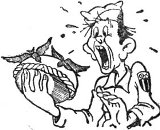
|
GIFT LAYS AN EGG
APO 629 (Chabua, India) - Feverishly S/Sgt. L. J. Gilka tore the wrappings off a package from the girl friend. A picture of his light-o'-love, maybe, Oh, boy!
There emerged rather a perceptibly out-of-date egged, dyed pink and charmingly decorated with two coy bluebirds. Probably a very pretty egg, at that, when mailed last April around Easter time.
UKHRUL SUPPLY BASE TAKEN BY 14TH ARMY
KANDY - Troops of the 14th Army have captured Ukhrul, important Jap supply base and threat to the security of Imphal, it was announced by SEAC HQ. Full details were not immediately available, but it was known that three British and Indian columns had been pushing toward Ukhrul, one from the north, one from the northeast, and one along the Imphal road from the southwest.
During the advance on Ukhrul the village of Sareikhong, 30 miles northeast of Imphal, was captured.
On Rajput Hill, northeast of the Palel-Tamu Road. British troops ousted Japanese defenders, killing 142.
SEAC communiqu s state that vigorous mopping-up operations have removed all Japanese operating west of the Imphal-Kohima Road and that east of the road there are only stragglers north of Karong. At Shorbung, in the same general area, ground operations, with vigorous air support, are progressing satisfactorily in an effort to clear out a pocket of enemy resistance.
Ukhrul was lost to the Nips the last week in March, early in their offensive towards the Manipur Plain. It was from this supply base the invaders branched out towards Imphal, Kohima and Dimapur.
JAPS CONVERGING UPON HENGYANG
CHUNGKING - (ANS) - The Japanese are converging on Hengyang in southeast China, in a strong effort to dominate the Hankow-Canton railway and thus isolate the eastern provinces, Lt. Gen. Joseph W. Stilwell's HQ reports.
Five Jap divisions have been moved south from Changsha, while Canton-based troops are sweeping up the rail line past Shiuchow. The American airfield at Hengyang has been abandoned, but the Chinese claim that the city is still in their possession. Planes of the 14th Air Force have bombed the field, rendering it unusable to the Japs.
The Chinese are reported counter-attacking against the Jap left and right wings and claim the recapture of Pingsiang, 100 miles northwest of Hengyang.
|
BROUGHT BACK CAPTIONS, DESPITE LACK OF TRAINING
In the early days, the pictorial history of the entire CBI Theater was recorded, within obvious limitations, by four photographers. These shutter-snapping gents, now enroute to Shangri-La, are shown at left, and the left to Eddie Jankowski, T/Sgt. Stephen Palinkas, T/3 Nicholas Lyseczko and Lt. William Cox.
With the advent of such things as photographic companies and Army Pictorial Services, these characters were scatted about the Theater to do odd jobs, with only the classic-featured Jankowski remaining on D/S with the Roundup.
Despite lack of training in some of the finer photographic arts as now practiced by the worthies of the Signal Corps, these second generation immigrant lads (Cox excepted) managed to get something that was pretty well composed, in focus and telling a story on a negative. They also wrote full and occasionally hilarious captions, which now appears to be a lost art.
Hep to the Jive
ALONG THE LEDO ROAD - The citizens of northern Burma are hep to the jive lingo and if you don't think that's a bottled in bond fact, you're an ickey.
A dusky, barefoot lad, crouching under the protection of his burlap rain covering, proferred this sage comment to an unsuspecting G.I., "Sahib, rain is teek nai." The dripping, soggy soldier was unimpressed.
Plainly disturbed by his apathy, the youngster bore down. "Sahib, rain is nai SOLID." - By Cpl. C. M. BUCHANAN.
JAPS COULDN'T BELIEVE IT
WHEN THEY FIRST SAW SUPER-FORT
CHINA - (UP) - The Japs had their first brush with the B-29 on April 26, long before the first mission, but never mentioned the incident, apparently unable to believe what they saw.
Col. Alan D. Clark had just crossed the Hump with one of the sky battleships, on a transport mission, when he sighted 12 planes near the Indo-Burma frontier identified as "Oscars." Six climbed to intercept the Super-Fort.
Tail Gunner Sgt. Harold Lanham became the first member of the 20th to inflict damage on the enemy as one of the planes went down in smoke, and the others scurried off.
THREE GIRLS OVER NIPPON
U.S. BETTY'S HONORED BY B-29'S
CHINA - (UP) - The codeword "Betty," by which B-29's announced themselves to the 20th Bomber Command while still over the target, was selected by Lt. Col. James D. Garcia for his wife, Betty Garcia, daughter of the president of Weirton Steel.
Garcia flew the mission with his brother-in-law, Lt. Col. Winston G. Close, whose wife's sister is named Betty. Garcia's plane was the second to give the "Betty" call from the target.
"Betty" further made 20th Bomber history when a radio operator, Cpl. Paul Turner, picked up the first "Betty" signal. Paul's girl is Betty J. Gorham.

|
'SAHIB, YOUR BATH READY'
Perils of Life in Rest Camp Revealed
By WALDORF GLEECH Roundup Correspondent
G.I. REST CAMP IN THE HIMALAYAS - "Sahib, your bath ready."
Ali, my bearer pro tem, made the announcement with regal solemnity, through what remained of his betel nut-stained teeth.
The words were music. Had I not suffered the torture of an Indian train ride for 28 hours and then careened wildly up a twisting mountain trail in a G.I. truck for another five and a half? As a consequence, such a layer of Mother India's top soil encrusted my epidermis I could have qualified for an end man in a minstrel show. Had the local chapter of the Erosion Committee entered the front door, I would have been forced to beat a hasty retreat out the back.
Aside from sanitary reasons, the ablutions were necessary to calm my jingle-jangled nerves. Victim of many a perilous ride, I was still not prepared for the mad dash from the train to the rest camp in a three-quarter ton. Chasms yawned thousands of feet along each side of the tortuous road, built for one-way traffic along most of its length. Did the driver weigh the consequences? Hell, no. Rather, they provided a challenge. Every foot was fraught with danger, surcharged with sudden death, as we swept around hairpin curves at breakneck speed, skirted precipices and defied every rule of the Drivers' Handbook.
When it was over, the "pilot" proudly proclaimed, "That was a new record for the run."
That I had been an unwilling stooge during this perilous assault upon automotive history did not seem to penetrate his mind, so saturated was it with pride.
"When do you get your Air Corps wings?" I asked weakly. My legs had all the strength of wet macaroni. I shook like an aspen in the breeze. Butterflies danced wildly in the pit of my stomach.
This sarcasm was wanted upon the fresh mountain air. My only answer was the resolute tread of his size 10½C's as he strode jubilantly off to announce the news to his fellow vehicle jockeys.
"Sahib, your bath ready."
My heart warmed toward Ali. Here, indeed, was the paragon of all bearers.
Then I was introduced to IT - the bathtub.
The most exacting purist could not have discerned a flaw in the tub's gleaming porcelain surface, its shining metal faucets, its beautiful symmetry, the clear warm water in which to luxuriate, the freshly unwrapped bar of soap.
However, there was a drawback. This tub, like all its mates in camp I later discovered, could only have been designed for the Singer Midgets. At first blush, I thought I was looking either at one of those appliances people

|
Imagine, if you will, a beefy matron struggling heroically into a new girdle. That draws a close parallel to my determined task of prying myself into the contraption. The situation cried for a jar of Vaseline.
Finally wedged into the devilish device, my movements were restricted more than somewhat. Chum, have you ever tried to bathe with your toes in your ears? It was the only tub in which I was ever able to wash my knees and my neck at the same time.
Escape was a problem, too. I toyed with and discarded several wild schemes - a small charge of blasting powder, a derrick, a can opener. Fortunately, I had just enough strength in reserve so that I didn't have to resort to any of these drastic measures. I wriggled out, flopped upon the floor, gasping like a fish out of water, and crawled into bed.
Next morning, Ali tiptoed into the room.
"Sahib, your bath ready," he suggested.
A G.I. shoe, a copy of Steinbeck's Cup of Gold, a flashlight and an empty tin of fruit juice thudded into the door.
But Ali was already out of the room.
He is an old hand at Rest Camp No. 1.
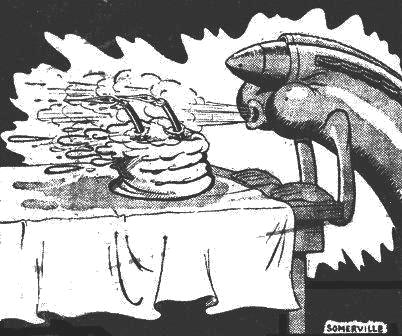
|
SALUTE TO 14TH AIR FORCE
Celebrates Second Anniversary
Seldom does a war run its crushing bloody course without there emerging an organization destined to become legendary.
The size of the unit does not materially effect the ultimate stature of the legend. In the Revolution, Roger's Rangers seldom had an operational strength of more than 500 men, yet they were the Merrill's Marauders of their day and are so known to history.
Stonewall Jackson's "foot cavalry," the marching fools of the Civil War, were, by modern standards, generally no stronger than a brigade. Their tendency to turn up where least expected and least wanted by the Northern armies became traditional.
The Spanish-American War had its Rough Riders; in World War I, the fighting 69th, the Rainbow Division and the 5th Marines (to mention just a few of many) established such reputations that even today mention of the name of the organization is sufficient to prompt recollections of long, bright pages in American military history.
Much less frequently, an outfit becomes a legend during a war and is able to grow with, sometimes outstrip, the fabulous tales of their deeds.
One such outfit in the present war is the 14th Air Force.
Two years ago the 4th of July, the 14th Air Force - then known as the American Army China Air Task Force - stepped into the shoes of the American Volunteer Group, the swashbuckling crew, part patriots, part mercenaries, who had successfully stiff-armed Jap air power in China for more than a year.
The AVG's were pros, experts, wise and battle hardened. They publicly wished the China Air Task Force well and privately wondered how long it would last, fighting in old, dilapidated P-40's; young pilots, lacking the specialized savvy, "the difference" that had enabled the AVG pilots to outsmart, out-fight, and out-kill (by a city block) Japs, who were flying better planes.
That the 14th Air Force is still there, and still, despite great distances and hard-to-come-by supplies, keeping the Jap on his collective heels, is largely due to the flying tactical genius of Maj. Gen. Claire L. Chennault.
For Chennault was the difference, the savvy, that made it possible for the 14th to take up when the AVG left off, hold their own, and more.
Former Commander of the American Volunteers, Chennault, along with Col. (then Maj.) Tex Hill, Robert "God is my co-pilot" Scott, and a few others, went over to the Air Force when the AVG was broken up.
Chennault knew almost all there was to know about the Jap Zero, the original Mitsubishi '00. Coupled with this was a profound knowledge of the limitations of the P-40 (early vintage) and of the multitude of uses to which bailing wire could be put in order that the P-40 might continue to fly. The general had long since discovered that the P-40 could come pretty close to coping with the Jap, but only by rigid pilot adherence to an unorthodox set of tactics which he had evolved from observation, elimination and sweat.
With a small nucleus of AVG veterans, Chennault nursed the 14th Air Force into being, kept it flying against superior odds and equipment, kept it fighting, and winning, all this at the far tag end of the longest supply line in the world, the veritable "end of the road."
Today, the 14th Air Force still operates out beyond the end of the line but, now, the bailing wire days are a thing of the past (except in a genuine emergency, of course) and medium and heavy bombers, as well as fighters and fighter-bombers, ply their lethal trade from Shanghai to Cape St. Jacques, which is the southern tip of Indo-China.
Because of the very nature of the war in China, the 14th is sometimes regarded, even by themselves, as a "defensive" air force. However, they have chosen to defend themselves, and a large part of China, at points located on the outer perimeter of the China Theater. Although the men of the 14th occasionally take the air to dispel intrusive Japanese near American bases, the bulk of their "defending" is done so far from their own bases that it takes those who crash-land three weeks to walk home.
The 14th Air Force has been accused, from time to time, of telling tall tales of their own accomplishments. But that is to be expected. The Green Mountain Boys and Robert Rogers' young men were frequently accused of rhetorical embroidery. That's the way with legendary armies. The trouble is that just when the scoffers have finished laughing over the whopper about sinking five ships with six bombs, in comes some disinterested neutral party and says: "You know, I was down to Amoy last week and what do you think happened? Some crazy American comes high-balling over there in a B-25, drops a couple of sticks of bombs and what do you think happened then? The sonofabitch sank FIVE ships, right in the harbor."
And so the legend grows.
Last year, on the first anniversary of the founding of the 14th, Chennault expressed the hope that his men would be over Japan itself before the first firecracker exploded on July 4, 1944.
But even if they weren't (Super-Fortresses, however, did the job), there can be no detraction from the value to the Allied cause, of the 1,004 Japanese aircraft the 14th has destroyed since Independence Day 1942, nor the value of the 414,939 tons of Jap shipping they have caused to float no more.
The going would be much tougher without Chennault and his men of the 14th Air Force.
The C.B.I. Roundup is a weekly newspaper of the United States Army Forces, published by and for the men in China, Burma, and India, from news and pictures supplied by staff members, soldier correspondents, the United Press, OWI, and Army News Service. The Roundup is published Thursday of each week and is printed by The Statesman in New Delhi, India. Editorial matter should be sent directly to Capt. Floyd Walter, Headquarters, U.S.A.F., C.B.I., New Delhi, and should arrive not later than Sunday in order to make that week's issue. Pictures must arrive by Saturday and must be negatives or enlargements. Stories should contain full name and organization of sender.

JULY 6, 1944
Adapted from the original issue of C.B.I. Roundup
Copyright © 2007 Carl Warren Weidenburner
TOP OF PAGE PRINT THIS PAGE ABOUT THIS PAGE SEND COMMENTS
PREVIOUS ISSUE CLOSE THIS WINDOW NEXT ISSUE
|
|
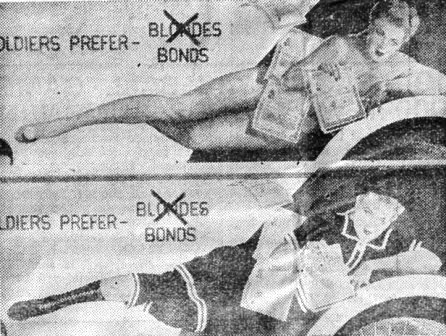 The mayor of Tucson and the City Ministerial Association agreed that a publicity campaign in the city's busses
would help the War Bond Drive. But when their horrified eyes saw the picture (top) of a bathing beauty dressed in
only a few scattered bonds, they maintained there should be limitations even to advertising zeal. The result was
that the bus company clothed the curvaceous miss in a Gay Nineties bathing suit.
The mayor of Tucson and the City Ministerial Association agreed that a publicity campaign in the city's busses
would help the War Bond Drive. But when their horrified eyes saw the picture (top) of a bathing beauty dressed in
only a few scattered bonds, they maintained there should be limitations even to advertising zeal. The result was
that the bus company clothed the curvaceous miss in a Gay Nineties bathing suit.
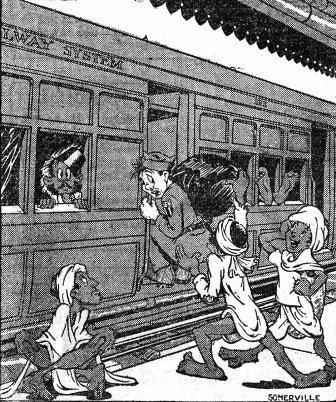 LOUIE LEAVING FOR A CHANGE AND REST - THE BEARERS HAVE ALL HIS CHANGE AND THE RAILROADS GOT THE REST
LOUIE LEAVING FOR A CHANGE AND REST - THE BEARERS HAVE ALL HIS CHANGE AND THE RAILROADS GOT THE REST
 It isn't every Theater of Operations which can boast a husband and wife team of accredited war correspondents.
Here we have Tilman Durdin and his wife, Peggy, representing the New York Times and Time, Inc.
respectively.
In this exclusive picture, posed especially for the Roundup, Peggy and Til interview an old and slothful
Yogi who is rumored to have dreamed up the B-29. It's all a little silly, but it was ever thus with the Roundup.
It isn't every Theater of Operations which can boast a husband and wife team of accredited war correspondents.
Here we have Tilman Durdin and his wife, Peggy, representing the New York Times and Time, Inc.
respectively.
In this exclusive picture, posed especially for the Roundup, Peggy and Til interview an old and slothful
Yogi who is rumored to have dreamed up the B-29. It's all a little silly, but it was ever thus with the Roundup.
